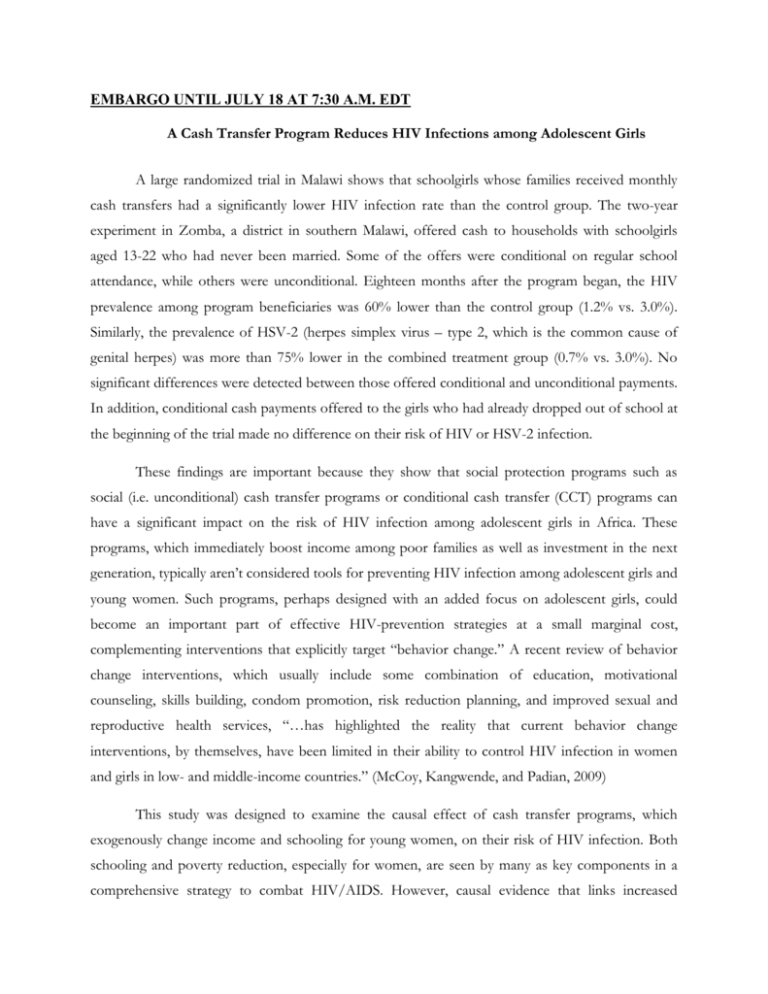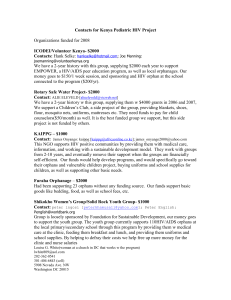
EMBARGO UNTIL JULY 18 AT 7:30 A.M. EDT
A Cash Transfer Program Reduces HIV Infections among Adolescent Girls
A large randomized trial in Malawi shows that schoolgirls whose families received monthly
cash transfers had a significantly lower HIV infection rate than the control group. The two-year
experiment in Zomba, a district in southern Malawi, offered cash to households with schoolgirls
aged 13-22 who had never been married. Some of the offers were conditional on regular school
attendance, while others were unconditional. Eighteen months after the program began, the HIV
prevalence among program beneficiaries was 60% lower than the control group (1.2% vs. 3.0%).
Similarly, the prevalence of HSV-2 (herpes simplex virus – type 2, which is the common cause of
genital herpes) was more than 75% lower in the combined treatment group (0.7% vs. 3.0%). No
significant differences were detected between those offered conditional and unconditional payments.
In addition, conditional cash payments offered to the girls who had already dropped out of school at
the beginning of the trial made no difference on their risk of HIV or HSV-2 infection.
These findings are important because they show that social protection programs such as
social (i.e. unconditional) cash transfer programs or conditional cash transfer (CCT) programs can
have a significant impact on the risk of HIV infection among adolescent girls in Africa. These
programs, which immediately boost income among poor families as well as investment in the next
generation, typically aren’t considered tools for preventing HIV infection among adolescent girls and
young women. Such programs, perhaps designed with an added focus on adolescent girls, could
become an important part of effective HIV-prevention strategies at a small marginal cost,
complementing interventions that explicitly target “behavior change.” A recent review of behavior
change interventions, which usually include some combination of education, motivational
counseling, skills building, condom promotion, risk reduction planning, and improved sexual and
reproductive health services, “…has highlighted the reality that current behavior change
interventions, by themselves, have been limited in their ability to control HIV infection in women
and girls in low- and middle-income countries.” (McCoy, Kangwende, and Padian, 2009)
This study was designed to examine the causal effect of cash transfer programs, which
exogenously change income and schooling for young women, on their risk of HIV infection. Both
schooling and poverty reduction, especially for women, are seen by many as key components in a
comprehensive strategy to combat HIV/AIDS. However, causal evidence that links increased
schooling or positive income shocks to reduced risk of HIV infection is very limited. While
education has been suggested as a “social vaccine” to prevent the spread of HIV (Jukes, Simmons,
and Bundy, 2008), most of the evidence we have on the link between schooling and HIV infection
comes from cross-sectional studies. The same is true of the relationship between poverty and
HIV/AIDS.
The trial -- Schooling, Income, and HIV Risk (SIHR) -- randomly enrolled 3,796 adolescent
girls and young women from 176 enumeration areas (EAs) in Zomba – a district with high HIV
rates and school dropout rates among adolescent girls. The study participants were females between
the ages of 13 and 22 at baseline who had never been married. They were divided into two main
groups: those who had already dropped out of school (baseline dropouts, who accounted for less than
15% of the study population) and those who were enrolled in school at baseline (baseline schoolgirls).
Treatment status was assigned at the EA level, so the sample of 176 EAs was randomly
divided into two equally sized groups: treatment and control. In the treatment EAs, all baseline
dropouts were offered conditional cash transfers. The sample of 88 treatment EAs was further
divided into three groups based on the treatment status of baseline schoolgirls: in 46 EAs a randomly
determined share of schoolgirls received conditional transfers; in 27 EAs a randomly determined share
of schoolgirls received unconditional transfers; and in the remaining 15 EAs only baseline dropouts
received treatment while the baseline schoolgirls received no transfers. Data on baseline schoolgirls who
lived in a treatment EA but were not sampled into treatment will be used to measure potential
spillover effects.
The payments include cash transferred to the parents, cash directly to the girl, and direct
payment of school fees for girls in the conditional treatment arm attending secondary schools.1 The
amount given to the parents was randomly chosen, ranging from $4 to $10/month, with all
recipients in a given EA receiving the same amount. The individual transfer amount was determined
by lottery, specifically when girls picked a number out of an envelope to win an amount between $1
Students have to pay school fees at the secondary level in Malawi, but not at the primary level. In the unconditional
treatment arm, for households with girls eligible to attend secondary schools, the monthly transfer amounts paid were
adjusted upwards by an amount equal to the average secondary school fees paid in the conditional treatment arm. This
ensured that the average transfers offered in both the conditional and unconditional EAs were identical and the only
difference between the two groups was the “conditionality” of the transfers on satisfactory school attendance.
1
and $5/month. Cash transfers took place monthly. As part of the program, school attendance of all
the conditional cash transfer recipients was checked every month and payment for the following
month was withheld for any student whose attendance rate was below 75%in the previous month.
No attendance checks were conducted for the unconditional treatment recipients, who received their
cash transfers every month by showing up at their cash transfer locations.
The cash transfer intervention, which was designed to last two years, started in January 2008
and ended in December 2009. Baseline data using individual and household surveys were collected
between September 2007 and January 2008 and follow-up data were collected between October
2008 and February 2009. Biomarker data on HIV and HSV-2 were collected between June and
September 2009. The omission of Biomarker data collection at the beginning of the program was
deliberate: as home-based voluntary counseling and testing (HCT) can be a powerful intervention
for HIV prevention in and of itself, the study team decided to forego HCT at baseline to be able to
assess the pure impact of the cash transfer intervention alone. However, as the study is a
randomized control trial with a large sample size, the treatment and control groups are identical
across a wide range of baseline attributes, many of which include predictors of HIV infection.
Therefore, there is no reason to think that HIV (and HSV-2) rates would be different in the
treatment and control groups at baseline, meaning that the follow-up prevalence rates can be used to
assess the impact of the program on HIV incidence with confidence.
The evidence suggests that the program substantially reduced the progression of both HIV
and HSV-2 among program beneficiaries. The rate of new HSV-2 infections is very high among this
particular age group of adolescent girls and young women, as a result of which the program impact
increases steeply with age. These can be seen in the figure below that contrasts HSV-2 prevalence
among baseline schoolgirls at follow-up by age groups:
HSV-2 Prevalence at follow-up by age and treatment status among baseline schoolgirls
The chance that the differences in HIV and HSV-2 prevalence between the treatment and
control group are due to a baseline imbalance is smaller than 0.003. So, what caused the program to
have such a large impact on new infections of sexually-transmitted infections among adolescent girls
and young women? The answer seems to be that the program not only changes the sexual behaviors
that are usually targeted by ABC campaigns, but the makeup of sexual partners and the frequency of
sexual activity as well.
The program delayed the onset of sexual activity among program beneficiaries and reduced
the number of partners among those who remained sexually active, but had no effect on condom
use. The largest observed effect of the program on sexual behavior is on the number of coital acts:
among the study sample sexually active at baseline and follow-up, the frequency of sexual activity
was substantially reduced for program beneficiaries. However, the evidence suggests that these
observed changes in self-reported sexual behavior account for less than half of the program’s impact
on HIV. The rest is due to a change in the risk profile of sexual partners. Simulations indicate that
HIV prevalence among male sexual partners of program beneficiaries is approximately 50% less
than the rate among partners of young women in the control group.
This is reflected in partner characteristics as reported by study participants. For example, it is
well-known that older males are, on average, much more likely to be HIV positive than the male
peers of schoolgirls. At the 12-month follow-up, the age gap between adolescent girls and their male
partners was one year smaller in the treatment group and the sexual partners were 33% more likely
to have been tested for HIV. In addition, the chances of having an older partner, as well as the
amount of gifts and cash received from the partner, decline significantly as the total amount of cash
payments offered by the program goes up.
Finally, it is interesting to ask whether the observed effects are due to increased school
enrollment or the positive income shock. Schooling is clearly an important correlate of STI status, as
shown in the table below: among the control group, the probability of being infected with at least
one STI is 2.9% for those attending school regularly at follow-up, compared with 14.7% among
those who are not. However, beneficiaries of unconditional cash transfers (UCT) who are not
attending school at follow-up are also significantly less likely to be infected with HIV or HSV-2 than
girls in the control group who are not attending school. This suggests that cash transfers to
households can reduce the HIV risk of adolescent girls through channels other than schooling -- for
example, by making it much less likely that they engage in “transactional sex.”
Prevalence of “any STI” by treatment status and schooling status at follow-up
Not attending
regularly
Attending
regularly
Total
Control
14.7%
164
2.9%
608
5.2%
772
UCT
0.0%
52
2.9%
194
2.4%
246
Total
11.6%
216
2.9%
802
4.6%
1018
These findings are based on Biomarker data collected 18 months after the beginning of the
cash transfer program, which means that the program was still ongoing at the time of data
collection. While it is important to document the gains against HIV infection in the short run, it is
also important to find out whether the impact of this program will last vs. simply delay the infection.
To this end, the research team is currently in the field collecting Biomarker data 6 months after the
completion of the cash transfer experiment, and will do so again in 2012 to assess longer term
impacts. But even a two-year delay in HIV infection should not be discounted: those are two more
years of life without AIDS the program beneficiaries can enjoy and two years without the possibility
of transmitting the virus to their sexual partners or their babies.
The findings here suggest that cash transfer programs that focus on adolescent girls can
empower them to steer away from risky sexual behavior and thus reduce their risk of HIV infection.
They also indicate that while ABC campaigns might no doubt be effective in fighting the disease,
empowering girls financially can also lead to reduced risk – not just by reducing their sexual activity
or having safer sex, but also by enabling them to choose partners who are less likely to be infected
with HIV.





